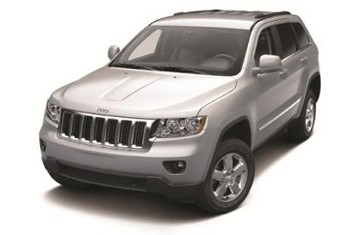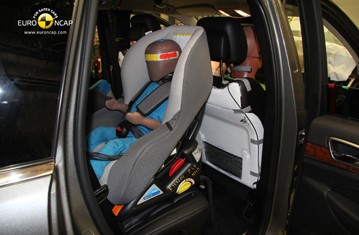Find more information in the General Comments section of the assessment
Find more information in the Rating Validity tab of the assessment
- See More
- See More
- See More
- See More
- Good
- Adequate
- Marginal
- Weak
- Poor
 Passenger
Passenger
 Driver
Driver
 Front Seat
Front Seat
 Car
Car
 Pole
Pole
- Good
- Adequate
- Marginal
- Weak
- Poor


Passenger
outboard
center
Fitted to the vehicle as standard
Not fitted to the test vehicle but available as option
Not Available
In the frontal impact, the 3 year dummy did not move forward excessively. However, on rebound, the dummy's head contacted the trim on the rear door pillar and the car lost all points for protection of the 3 year dummy in that test. The passenger airbag cannot be disabled so a rearward facing child restraint should not be used in that seating position. The dangers of doing so are not clearly labelled in the car.
- Good
- Adequate
- Marginal
- Weak
- Poor

Head Impact 10.1 Pts
Pelvis Impact 0.0 Pts
Leg Impact 6.0 Pts
The bumper provided good protection in all areas tested and scored maximum points. However, the front edge of the bonnet was poor in all areas tested. In almost all areas likely to be struck by the head of a child, the bonnet provided poor protection. However, protection provided to an adult's head was mixed with areas of good and poor protection.
- Good
- Adequate
- Marginal
- Weak
- Poor
| Performance | ||
| Vehicle Yaw Rate @ COS + 1.00 s | 1.283% | meets ECE requirements |
| Vehicle Yaw Rate @ COS + 1.75 s | 1.022% | meets ECE requirements |
| Lateral Displacement @ BOS + 1.07 s | 2.85 m | meets ECE requirements |
| Applies To | Front seats | ||
| Warning | Driver Seat | Front Passenger(s) | Rear Passenger(s) |
| Visual | |||
| Audible | |||
|
|||
Electronic stability control is standard equipment on the Grand Cherokee and met Euro NCAP's test requirements. A seatbelt reminder system is standard equipment for the driver and front passenger seats. A sped limitation device is not offered on the Grand Cherokee.
- Specifications
- Safety Equipment
- Videos
- Rating Validity
Specifications
Tested Model Jeep Grand Cherokee, 3.0 diesel 'Limited', LHD
Body Type - 5 door off roader
Year Of Publication 2011
Kerb Weight 2326kg
VIN From Which Rating Applies - applies to all Grand Cherokees of the specification tested
Class Large Off-Road 4x4
Safety Equipment
Note: Other equipment may be available on the vehicle but was not considered in the test year.
Fitted to the vehicle as standard
Fitted to the vehicle as option
Not fitted to the test vehicle but available as option
Not Available
Not Applicable
Videos
Rating Validity



Find more information in the General Comments section of the assessment
 Share
Share











In the frontal impact, the driver's inboard seat rail was found to have very nearly broken in two, and was mainly held together only by the threaded steel rod which controls fore-aft adjustment of the seat. The break occurred just at the point where the lower anchorage for the driver's seat belt attaches to the rail, and is thought to have been caused by the high tensile forces in the belt during the test. As a result, there was additional forward movement of the dummy which contributed to 'bottoming out' of the airbag i.e. there was insufficient pressure in the airbag to prevent the driver's head from making contact, through the fabric of the airbag, with the steering wheel rim. Jeep has investigated the cause of the seat rail failure and cars from VIN 1C4RJFJG4EC139637 have a modified design to prevent such fracture. Earlier cars have not been modified. Although dummy readings were good, structures in the dashboard were thought to present a risk of injury to the knees and femurs of occupants of different sizes and to those sat in different positions. Maximum points were scored in the side barrier test but, in the more severe side pole impact, protection of the chest was rated as marginal. The Grand Cherokee has an 'active' head restraint which senses when a rear-end impact has occurred and moves the restraint forward to minimise the time to restrain head movement. Jeep showed that the system responded in a broad range of accident severities, and the whiplash tests were performed with the system active. Nevertheless, the protection provided against neck injuries in a rear-end collision was rated as marginal.